
Sulawesi, also known as Celebes, is an island in Indonesia. One of the four Greater Sunda Islands, and the world's 11th-largest island, it is situated east of Borneo, west of the Maluku Islands, and south of Mindanao and the Sulu Archipelago. Within Indonesia, only Sumatra, Borneo, and Papua are larger in territory, and only Java and Sumatra have larger populations.
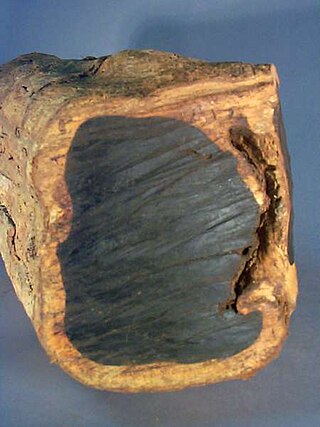
Ebony is a dense black/brown hardwood, coming from several species in the genus Diospyros, which also includes the persimmon tree. Few Diospyros species such as macassar and mun ebony are dense enough to sink in water. Ebony is finely textured and has a mirror finish when polished, making it valuable as an ornamental wood. It is often cited as one of the most expensive woods in the world.
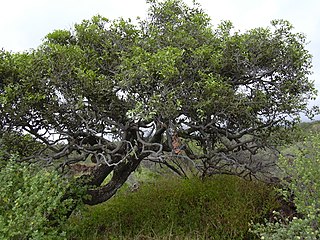
The Ebenaceae are a family of flowering plants belonging to order Ericales. The family includes ebony and persimmon among about 768 species of trees and shrubs. It is distributed across the tropical and warmer temperate regions of the world. It is most diverse in the rainforests of Malesia, India, tropical Africa and tropical America.
Macassar, Makassar or Makasar may refer to:
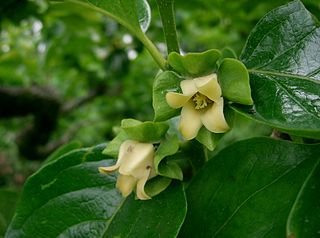
Diospyros is a genus of over 700 species of deciduous and evergreen trees and shrubs. The majority are native to the tropics, with only a few species extending into temperate regions. Individual species valued for their hard, heavy, dark timber, are commonly known as ebony trees, while others are valued for their fruit and known as persimmon trees. Some are useful as ornamentals and many are of local ecological importance. Species of this genus are generally dioecious, with separate male and female plants.

Diospyros virginiana is a persimmon species commonly called the American persimmon, common persimmon, eastern persimmon, simmon, possumwood, possum apples, or sugar plum. It ranges from southern Connecticut to Florida, and west to Texas, Louisiana, Oklahoma, Kansas, and Iowa. The tree grows wild but has been cultivated for its fruit and wood since prehistoric times by Native Americans.
Ebony is a dense black hardwood.
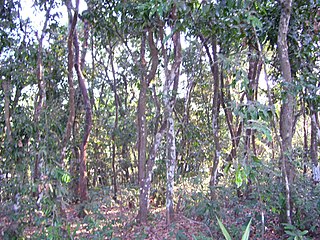
Diospyros ebenum, or Ceylon ebony , is a species of tree in the genus Diospyros and the family Ebenaceae. The tree produces valuable black wood.

Agathis dammara, commonly known as the Amboina pine or dammar pine, is a coniferous timber tree native to Sulawesi, the Maluku Islands and the Philippines.
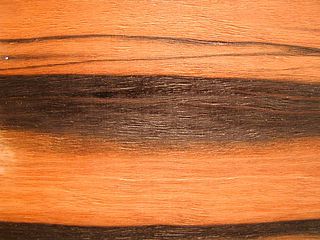
Variegated ebony is a group of valuable hardwood varieties, generally obtained from several species in the genus Diospyros, related to genuine ebony. The wood has been used for furniture but also in carpentry, luthiery, and sculpture.
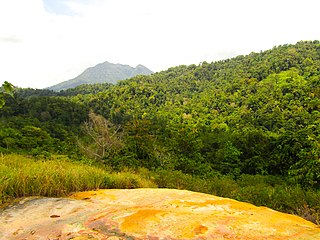
Bogani Nani Wartabone National Park is a 2,871 km2 (1,108 mi2) national park on Minahassa Peninsula on Sulawesi island, Indonesia. Formerly known as Dumoga Bone National Park, it was established in 1991 and was renamed in honour of Nani Wartabone, a local resistance fighter who drove the Japanese from Gorontalo during World War II. The park has been identified by Wildlife Conservation Society as the single most important site for the conservation of Sulawesi wildlife and is home to many species endemic to Sulawesi.
The wildlife of Mauritius consists of its flora and fauna. Mauritius is located in the Indian Ocean to the east of Madagascar. Due to its isolation, it has a relatively low diversity of wildlife; however, a high proportion of these are endemic species occurring nowhere else in the world. Many of these are now threatened with extinction because of human activities including habitat destruction and the introduction of non-native species. Some have already become extinct, most famously the dodo which disappeared in the 17th century.

Poso Regency is a regency of Central Sulawesi Province of Indonesia. It covers an area of 7,112.25 km2, and had a population of 209,228 at the 2010 Census and 244,875 at the 2020 Census; the official estimate as at mid 2022 was 252,650. The principal town lies at Poso.

Diospyros crassiflora, commonly known as Gabon ebony, African ebony, West African ebony, and Benin ebony is a species of lowland-rainforest tree in the family Ebenaceae that is endemic to Western Africa. It is named after the West African state of Gabon, though it also occurs in Cameroon, Central African Republic, Republic of the Congo, Democratic Republic of the Congo, Equatorial Guinea and Nigeria.
Diospyros oppositifolia is a species of tree in the ebony family, Ebenaceae. It is endemic to Sri Lanka.
Diospyros hirsuta is a tree in the ebony family endemic to Sri Lanka.
Diospyros quaesita or calamander is a species of tree endemic to Sri Lanka. in Sinhala, this tree is called kalu mediriya. This large tree occurs in the evergreen forests of lowland wet zones. This tree is found in 25 forest sites.

Diospyros tessellaria is a species of tree in the family Ebenaceae.

Diospyros revaughanii is a rare species of tree in the family Ebenaceae (ebony).

Diospyros egrettarum is a species of tree endemic to Mauritius and was once a dominant species throughout dry and coastal forests. Due to harvests for timber and firewood in the past the species was reduced to fewer than 10 individuals on the main land. The only viable population remained on Île aux Aigrettes, a coral island off the east coast, where it was able to survive thanks to protective measures, such as the eradication of exotic plants and rats. The tree is named after this Island.
















